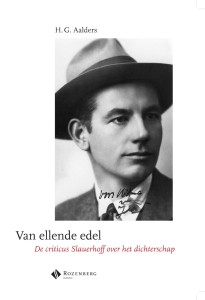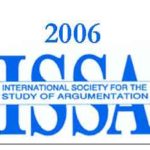Van ellende edel. Bijlage III ~ Corbières besproken gedichten (hoofdstuk 7.4.2)
Ce n’est pas une ville, c’est un monde.
— C’est la mer: — calme plat — et la grande marée,
Avec un grondement lointain, s’est retirée.
Le flot va revenir, se roulant dans son bruit —
— Entendez-vous gratter les crabes de la nuit …
5 — C’est le Styx asséché : Le chiffonnier Diogène,
Sa lanterne à la main, s’en vient errer sans gêne.
Le long du ruisseau noir, les poëtes pervers
Pêchent ; leur crâne creux leur sert de boîte à vers.
— C’est le champ : Pour glaner les impures charpies
10 S’abat le vol tournant des hideuses harpies.
Le lapin de gouttière, à l’affût des rongeurs,
Fuit les fils de Bondy, nocturnes vendangeurs.
— C’est la mort : La police gît — En haut, l’amour
Fait la sieste en têtant la viande d’un bras lourd,
15 Où le baiser éteint laisse sa plaque rouge …
L’heure est seule — Écoutez : … pas un rêve ne bouge
— C’est la vie : Écoutez : la source vive chante
L’éternelle chanson, sur la tête gluante
D’un dieu marin tirant ses membres nus et verts
20 Sur le lit de la morgue … Et les yeux grand’ouverts ! Read more
Van ellende edel. Bijlage IV ~ Slauerhoffs stuk over Lautréamont
L’influence de Lautréamont ne s’est fait sentir qu’après la guerre. Et ce n’est qu’en ces dernières années que son cas est au centre de l’intérêt. Je ne puis me rendre compte si cela est dû au fait que Lautréamont, de même que le maréchal Foch, est né à Tarbes,[i] ou à cette autre circonstance que, de même que l’équipe de football victorieuse aux récents Jeux Olympiques, il s’est formé dans l’Uruguay et qu’il a transplanté en Europe une énergie et une vitesse inconnues. Il se pourrait que les horoscopes de ces grandeurs nous donnent à ce sujet quelques éclaircissements.
Le cas Lautréamont rappelle très fort le cas Rimbaud, auquel il est partiellement parallèle.
Tous les deux coïncident avec l’époque de la plus grande humiliation française, vers 1870. L’un et l’autre ont accompli en quelques années une oeuvre aux proportions grandioses et absolument neuves. Une mort prématurée, littéraire chez l’un, physique chez l’autre, est venu mettre un terme à une période d’intensité surhumaine. Nous nous étendrons plus loin sur ce qui les distingue.
Mais il nous faut examiner d’abord quelle est la signification de ces deux phénomènes pour la vie intellectuelle de l’Europe au cours du siècle dernier.
Ils constituent la preuve la plus forte que, depuis un siècle, l’orientation de la littérature européenne ou plutôt de la vie intellectuelle au sens non scientifique mais essentiel, est dominée, non pas par des esprits de formation classique universelle et très conscients d’eux-mêmes (Voltaire-Goethe etc.), mais par des individualités anormales, qu’aucun lien ne rattache à leur temps ni à leur pays, qui se manifestent en pleine autonomie et doivent généralement se maintenir contre une société hostile. Read more
Van ellende edel. Bijlage V ~ Slauerhoffs besproken gedichten (hoofdstuk 11 en 13)
 De Ardennen (Vg 827/8)
De Ardennen (Vg 827/8)
Een (gebroken) Sonnettenkrans, door Jacquelin
I. Pelgrimstocht
O, de gewijde grotten! Wij bezochten
Om te beginnen die van Remouchamps,
Liefkoosden warm in de ijskoude krochten,
En daalden daarna in die van Dinant,
Een pas ontdekte – België is hòl er van
Sinds de entrees stegen op meer dan tien francs.
De vroomheid bleef. ’t Vermogen niet. Wij kochten
Ons niet meer ’t Allerheiligste van Han,
En zochten troost in Brussels Scala, voor
De ontwijding van het Heilge Land van Tachtig,
En vonden met verrukking, achter ’t koor,
België’s Libanon nu eerst waarachtig
Grootsch: grotten grijnsden, gletschers glansden prachtig,
Want hier beleed zich oprecht het Décor. Read more
Van ellende edel ~ Bibliografie
 Abrams, M.H. – 1953 The Mirror and the Lamp. Romantic Theory and the Critical Tradition. Oxford University Press. Londen / Oxford / New York.
Abrams, M.H. – 1953 The Mirror and the Lamp. Romantic Theory and the Critical Tradition. Oxford University Press. Londen / Oxford / New York.
Akker, W.J. van den – 1984 ‘En marche vers le ciel. Over “Het lied der dwaze bijen”’. In: De revisor 11 (1984) 4 (aug): 72–79,85.
Akker, W.J. van den – 1985 Een dichter schreit niet. Over de versexterne poëtica van M. Nijhoff. 2 dln. Proefschrift Utrecht. Veen. Utrecht.
Akker, W.J. van den – 1987 ‘De schrijver in een impasse; over “De schrijver” van M. Nijhoff (I)’. In: De nieuwe taalgids 80 (1987) no. 5: 386–406.
Akker, W.J. van den en G.J. Dorleijn – 1985 ‘Stemmen uit de redactie. Een documentatie over het redactiebeleid van De gids tussen 1916 en 1926’. In: W.J. van den Akker e.a. (red.), Traditie en vernieuwing. Opstellen aangeboden aan A.L. Sötemann. Veen. Utrecht / Antwerpen: 146–177.
Anbeek, T. – 1996 Het donkere hart. Romantische obsessies in de moderne Nederlandstalige literatuur. Amsterdam University Press. Amsterdam.
Anbeek, T. – 1999 Geschiedenis van de literatuur in Nederland, 1885–1985. Arbeiderspers. Amsterdam / Antwerpen. 5de, herz. dr. (1ste dr. 1990).
Bai Juyi – 2001 Gedichten en proza. Vertaling en toelichting W.L. Idema. Atlas. Amsterdam / Antwerpen.
Bakker, S. – 2002 ‘J. Slauerhoff’. In: A. Zuiderent, H. Brems en T. van Deel (red.), Kritisch lexicon van de moderne Nederlandstalige literatuur. 86ste aanv., aug.
Baudelaire, Ch. – 1976 O’Euvres complètes II. Éd. C. Pichois. Gallimard. Parijs. Bibliothèque de la Pléiade no. 7].
Baudelaire, Ch. – 1995 De bloemen van het kwaad. Vertaling en commentaar P. Verstegen. Van Oorschot. Amsterdam [Franse bibliotheek – klassiek]. Tweetalige uitgave (integrale vertaling van de 2de druk van Les Fleurs du mal. Poulet-Malassis et De Broise. Parijs 1861)
Bergh, Hans van den – 2002 ‘Paul Verlaine – voorvechter van het symbolisme?’. In: De tweede ronde 23 (2002) 3 (herfst): 91–99 [Verlaine-nummer].
Bergh, Herman van den – 1918 ‘Studiën (tweede reeks) VI: Van grondslag en onderscheid’. In: Het getij 3 (1918): 192–196. Ook in: idem, Nieuwe tucht. Studiën over litteratuur. De Spieghel. Amsterdam z.j. [1928]: 7–13. Read more
De wereld draait door ~ Van Dis en Meinderts over de nalatenschap van Slauerhoff (April 2014)
Het Letterkundig Museum in Den Haag bemachtigde de literaire nalatenschap van zwervend dichter en schrijver J.J. Slauerhoff. Adriaan van Dis en museumdirecteur Aad Meinderts lichtten toe wat er in de kist en vijftig dozen werd aangetroffen.
VARA ~ De wereld draait door ~ april 2014
ISSA Proceedings 2006 – Ehninger’s Argument Violin
 Douglas Ehninger’s theoretical gem, “Argument as Method” (1970), introduces us to two unsavory debate characters. First, there is the “neutralist” – an interlocutor who eschews commitment at every turn. Following the Greek philosopher Pyrrho, the neutralist thinks that since nothing can be known, standpoints should float freely, unanchored by the tethers of belief. The neutralist’s counterpart is the “naked persuader” – someone who approaches argument like Plato’s Callicles – clinging doggedly to preconceived beliefs and resisting any shift no matter how compelling the counterpoints (Ehninger 1970, p. 104).
Douglas Ehninger’s theoretical gem, “Argument as Method” (1970), introduces us to two unsavory debate characters. First, there is the “neutralist” – an interlocutor who eschews commitment at every turn. Following the Greek philosopher Pyrrho, the neutralist thinks that since nothing can be known, standpoints should float freely, unanchored by the tethers of belief. The neutralist’s counterpart is the “naked persuader” – someone who approaches argument like Plato’s Callicles – clinging doggedly to preconceived beliefs and resisting any shift no matter how compelling the counterpoints (Ehninger 1970, p. 104).
Naked persuaders and neutralists each have difficulty engaging in argument, but for different reasons. According to Ehninger (1970, p. 104), argumentation is a “person risking enterprise,” and by entering into an argument, “a disputant opens the possibility that as a result of the interchange he too may be persuaded of his opponent’s view, or, failing that, at least may be forced to make major alterations in his own.” In this account, naked persuaders are hamstrung by their unwillingness to risk the possibility that the force of reason will prompt alteration of their views. Neutralists, on the other hand, prevent the “person risking enterprise” from ever getting off the ground in the first place, since they place nothing on the table to risk.
Ehninger’s unsavory characters illustrate how the concept of standpoint commitment has salience in any theory of “argument as process” (Wenzel 1990). To reap the full benefits of the process of argumentation, interlocutors must adopt stances vis-à-vis their standpoints that strike an appropriate balance between perspectives of the naked persuader and the neutralist. For Ehninger (1970, p. 104), such a balanced posture consists of “restrained partisanship,” where advocates drive dialectic forward with tentative conviction, while remaining open to the possibility that the course of argument may dictate that their initial standpoints require amendment or retraction. Finding this delicate balance resembles the tuning of violin strings – a metaphor that underscores his point that the proper stance of restrained partisanship must be tailored to fit each situation.
The public argument prior to the 2003 Iraq War offers a clear example of a poorly tuned deliberative exchange. While several official investigations (e.g. US Commission 2005; US Senate 2004) have explained the breakdown in prewar decision-making as a case of faulty data driving bad policy, this paper explores how the technical concept of foreign policy “intelligence failure” (Matthias 2001) can be expanded to offer a more fine-grained explanation for the ill-fated war decision, which stemmed in part from a failure of the argumentative process in public spheres of deliberation. Part one revisits Ehninger’s concept of standpoint commitment, framing it in light of related argumentation theories that address similar aspects of the argumentative process. This discussion paves the way for a case study of public argument concerning the run-up to the 2003 Iraq War. Finally, possible implications of the case study for foreign policy rhetoric and argumentation theory are considered. Read more


